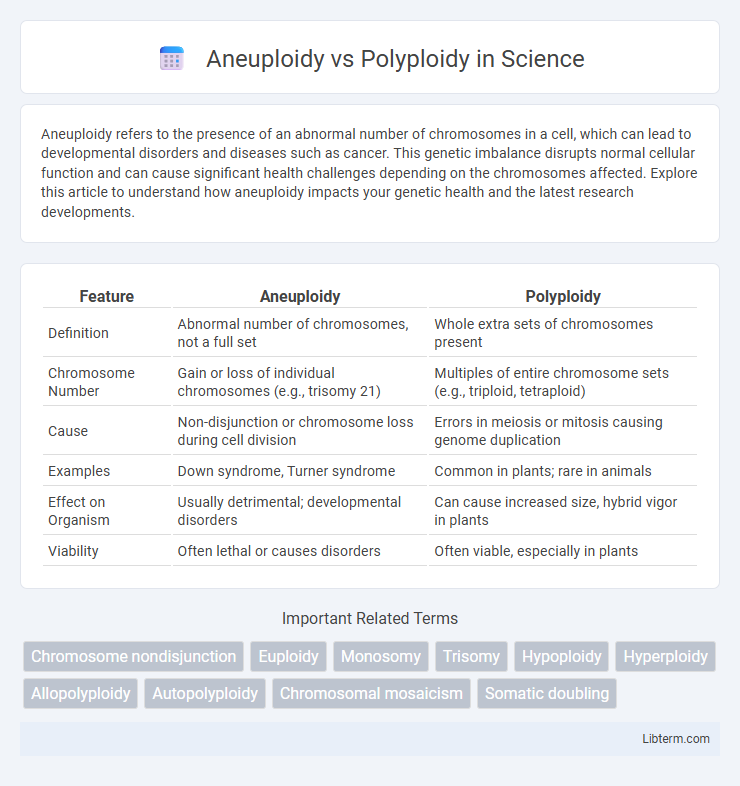Aneuploidy refers to the presence of an abnormal number of chromosomes in a cell, which can lead to developmental disorders and diseases such as cancer. This genetic imbalance disrupts normal cellular function and can cause significant health challenges depending on the chromosomes affected. Explore this article to understand how aneuploidy impacts your genetic health and the latest research developments.
Table of Comparison
| Feature | Aneuploidy | Polyploidy |
|---|---|---|
| Definition | Abnormal number of chromosomes, not a full set | Whole extra sets of chromosomes present |
| Chromosome Number | Gain or loss of individual chromosomes (e.g., trisomy 21) | Multiples of entire chromosome sets (e.g., triploid, tetraploid) |
| Cause | Non-disjunction or chromosome loss during cell division | Errors in meiosis or mitosis causing genome duplication |
| Examples | Down syndrome, Turner syndrome | Common in plants; rare in animals |
| Effect on Organism | Usually detrimental; developmental disorders | Can cause increased size, hybrid vigor in plants |
| Viability | Often lethal or causes disorders | Often viable, especially in plants |
Introduction to Chromosomal Abnormalities
Chromosomal abnormalities involve changes in the number or structure of chromosomes, impacting genetic stability. Aneuploidy refers to the presence of an abnormal number of chromosomes, such as trisomy 21 causing Down syndrome. Polyploidy involves the duplication of entire chromosome sets, common in plants but often lethal in animals.
Defining Aneuploidy: Causes and Types
Aneuploidy is a chromosomal abnormality characterized by the presence of an abnormal number of chromosomes, either missing or extra, deviating from the typical diploid set. It arises primarily due to nondisjunction events during meiosis or mitosis, leading to trisomy, monosomy, or other chromosome number variations. Common types of aneuploidy include trisomy 21 (Down syndrome), monosomy X (Turner syndrome), and trisomy 18 (Edwards syndrome), each associated with distinct phenotypic effects and clinical outcomes.
Polyploidy Explained: Origins and Varieties
Polyploidy refers to the condition where an organism possesses more than two complete sets of chromosomes, typically arising from errors in cell division or hybridization events. Common varieties include autopolyploidy, where chromosome duplication occurs within a single species, and allopolyploidy, resulting from the combination of chromosomes from different species. Polyploidy plays a significant role in plant evolution, speciation, and agricultural crop development due to its impact on genetic diversity and adaptation.
Key Differences Between Aneuploidy and Polyploidy
Aneuploidy involves an abnormal number of individual chromosomes, such as trisomy or monosomy, resulting from nondisjunction during cell division. Polyploidy refers to the presence of one or more extra complete sets of chromosomes, often observed in plants and some animals, leading to triploid or tetraploid cells. The key difference lies in the scale of chromosomal alteration, with aneuploidy affecting chromosome number on a segmental level and polyploidy altering the entire genome's chromosome set count.
Genetic Mechanisms Behind Chromosomal Variation
Aneuploidy arises from nondisjunction events during meiosis or mitosis, leading to the gain or loss of individual chromosomes and resulting in an abnormal chromosome number. Polyploidy involves whole-genome duplication through errors in cell division, producing cells with multiple complete sets of chromosomes, often seen in plants and some animal species. Both mechanisms reflect disruptions in chromosomal segregation but differ fundamentally in scale, with aneuploidy affecting individual chromosomes and polyploidy impacting entire chromosome sets.
Aneuploidy: Effects on Human Health
Aneuploidy, characterized by an abnormal number of chromosomes, often results in severe genetic disorders such as Down syndrome, Turner syndrome, and Klinefelter syndrome. This chromosomal imbalance disrupts gene expression and cellular function, leading to developmental abnormalities, intellectual disabilities, and increased risk of cancer. Unlike polyploidy, which involves whole sets of chromosomes and is generally lethal in humans, aneuploidy specifically affects individual chromosomes, making it a critical factor in human health and disease research.
Polyploidy in Plants and Evolutionary Significance
Polyploidy in plants involves the presence of more than two complete sets of chromosomes, often leading to increased genetic variation and enhanced adaptability. This chromosomal variation plays a crucial role in plant evolution by promoting speciation, hybrid vigor, and environmental resilience. Unlike aneuploidy, which involves changes in individual chromosome numbers and often causes detrimental effects, polyploidy contributes positively to diversification and agricultural improvement.
Diagnostic Techniques for Chromosomal Imbalances
Diagnostic techniques for chromosomal imbalances such as aneuploidy and polyploidy include karyotyping, fluorescence in situ hybridization (FISH), and comparative genomic hybridization (CGH). Karyotyping visually identifies the presence or absence of specific chromosomes, while FISH uses fluorescent probes to detect numerical and structural abnormalities with higher resolution. CGH offers genome-wide analysis to detect gains or losses of chromosomal material, enabling precise diagnosis of aneuploid conditions and polyploid states.
Clinical Implications and Case Studies
Aneuploidy, characterized by an abnormal number of chromosomes, frequently results in clinical conditions such as Down syndrome, Turner syndrome, and various cancers due to gene dosage imbalances affecting cellular function. Polyploidy, involving the duplication of entire chromosome sets, is less common in humans but plays a significant role in tumor progression and can lead to developmental abnormalities or lethality in embryonic stages. Case studies reveal that aneuploidy detection through prenatal screening and cancer diagnostics is crucial for early intervention, while understanding polyploidy mechanisms offers potential therapeutic targets in oncology.
Future Research Directions in Cytogenetics
Future research in cytogenetics will emphasize advanced genomic sequencing technologies to differentiate aneuploidy and polyploidy mechanisms with higher precision. Innovations in single-cell analysis and CRISPR-based gene editing hold potential for targeted studies on chromosomal instability and therapeutic interventions. Integration of machine learning models will enhance prediction of aneuploidy-related diseases and optimize agricultural applications involving polyploid crops.
Aneuploidy Infographic

 libterm.com
libterm.com